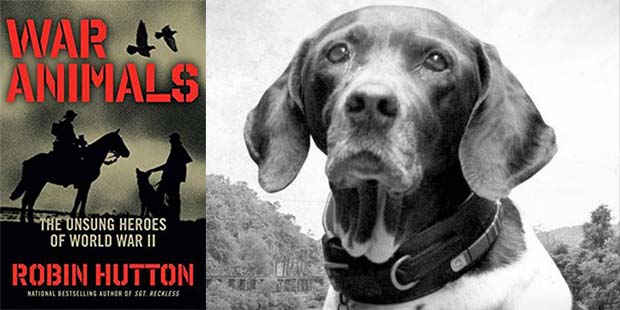
Many families during Thanksgiving express what they are thankful for. They have a gratitude for survival, the sharing of victories and struggles. Stories are retold of what people hold most precious, the core values of love, courage and generosity. A recently published book shows how people’s furry friends answered the call to duty.
“War Animals” by national bestselling author Robin Hutton recounts the experiences of the forgotten members of the Greatest Generation. Horses, mules, dogs and pigeons were all a part of the Allied war machine. They were messengers, spies and sentinels. They carried supplies to the front, comforted wounded soldiers, became a POW and were a vital part of the search and rescue effort during the German Blitz of London.
This is Hutton’s second book in the “War Animal” series. In the first one, she recounted the story of Reckless, a sorrel mare, small for her size that joined the Marines during the Korean War. Employed to help move heavy recoilless rifles and ammunition across steep and treacherous terrain, she regularly proved her bravery and endurance, making precarious trips hauling ammunition to soldiers in need, often during heavy fire. Once home, news of her promotion to staff sergeant quickly spread, though that notoriety has since faded. Hutton’s passion and admiration for Reckless are shown when she raised the money for not one but three monuments to this courageous horse at Quantico, Camp Pendleton and at the Kentucky Horse Park.
In this latest book, incredible and inspiring true stories are told of some animals who received the People’s Dispensary for Sick Animals Dickin Medal during WWII and lesser-known stories of other military animals whose acts of heroism have, until now, been largely forgotten. Founded in 1943, the prestigious PDSA Dickin Medal is the highest award an animal can achieve for gallantry and bravery in the field of military conflict, a Victoria Cross of sorts for animals.

Robin Hutton
War dogs came about after the Japanese attack on Pearl Harbor. Instead of originating from within the military, it was founded by a New York socialite, Arlene Erlanger. She was a poodle breeder and wanted to help the Allied effort. Starting a grassroots movement, she created Dog for Defense Inc., a volunteer organization that recruited a canine army, known as the K-9 Corps. Owners of dogs donated their personal pets to the war effort. The 40,000 animals were whittled down to about 19,000 after the first cut, but ultimately just more than 10,000 were chosen. The requirements said dogs had to be 28 inches tall at the shoulder and no more than 5-years-old. Once trained, they were put on assignment with strict secrecy imposed.
Each of these stories will leave readers spellbound, but the most heartfelt one is of Judy, an English pointer. Chosen as a mascot for a Royal Navy gunboat, she provided a huge morale boost. After some of the crew was reassigned to another ship, Judy went with them. In 1942, attacked by more than 100 Japanese bombers, the ships sank, but luckily Judy survived the shipwreck with some crewmembers.
On March 18, 1942, Judy and the surviving sailors were captured by the Japanese and became prisoners of war in forced labor camps. A new arrival, RAF pilot Frank Williams, took pity on her and decided that she would be his companion. He taught her to obey signals and whispered speech, while she brought scraps of food she salvaged to him. Transferred to an even more brutal labor camp, Frank worked up to 16 hours a day to build railroad tracks. Williams described her as, “A skinny animal that kept herself alive through cunning and instinct … I do not exaggerate when I say that this dog, with her example of courage to live, saved many of us who would surely have died.”
Liberated in August 1945 by the allied soldiers, she lived with Frank until her death on Feb. 16, 1950.
“When I heard about Judy, I knew she would be the heart and soul of this book,” Hutton said. “Her story touched me and it would also touch readers. She was resilient and became the heart of the POW camp. The men would say, ‘If Judy can make it, so can I.’ They persevered because of her and never gave up. Today dogs are used to help with PTSD, and back then Judy was no different. She provided comfort and security.”
Another brave dog was Chips, a German shepherd trained as a sentry who attacked an Italian machine gun team, sustaining powder burns and saving his handler’s life. He actually received the Silver Star, but it was revoked in 1944 after a national commander complained.
Known as “Mr. Chips,” he was honorably discharged on Dec. 10, 1945. Pvt. John Rowell, who served with the canine partner, wrote, “We went through a lot together … he is really wonderful. He saved my life more than once when things were tough.”
Hutton decided “to nominate Chips for a Dickin’s Medal since he is America’s most decorated war dog. He received it this January.”
The British also started up a war dog program in May 1941 and asked for citizens to volunteer their dogs. The War Dogs Training School officially opened for business on May 5, 1942, at a greyhound kennel in Northaw. Forty recruits were awaiting training. By the end of the war, some 3,300 had been successfully dispatched to units across the globe.
But some of the most special dogs were those used for search and rescue. As the British Prime Minister Winston Churchill said of the German blitz, “Hitler hopes by killing large numbers of civilians and women and children that he will terrorize and cow the people of this mighty imperial city and make them a burden of anxiety to the government … Little does he know the spirit of the British nation.” This includes the dogs that located buried air raid victims.
Irma is an example of how the dogs gallantly found survivors — an Alsatian bred with exceptional intelligence and a strong devotion to duty. Her owner wrote in 1945, “Irma gave the position of victims under a collapsed house, and although there was some doubt in the minds of the men who were working on the ruins, excavations were made. As a result, they discovered two girls, both alive. This rescue was especially impressive because Irma refused to give up on the location, and kept returning to it, even after two days. Only because of her tenacity did the two girls survive.”
Today there are dogs whose duties are search and rescue and others that recover. Irma was a pioneer since she was able to discern if a victim was alive or dead and inform the human rescuers with different barks.
Hutton said she hopes readers discover the heart of the animals and “how they will do anything for us.
“They deserve to be honored because they answered the call of duty,” she said. “I have some projects that I hope will do just that. I am putting together an International War American Museum in Washington, D.C., where people can learn about these wonderful animals. I think there should be a medal of honor for dogs served. Each branch should have a medal to bestow on these animals. I also would love to do a war animal TV series that would have two or three stories with re-enactments showing the role they had throughout history, especially during wartime.”
In reading this book, people are able to see how the animals served valiantly. An added bonus — through the animals’ eyes readers are informed about the events that occurred during World War II.
